Combined Heat and Power Dispatch Considering Heat Storage of Both Buildings and Pipelines in District Heating System for Wind Power Integration
Abstract
:1. Introduction
- A novel CPB-CHPD model is proposed with special emphasis on the coordinating operation of both PDTP and BTI aiming at breaking the power and heat coupling to significantly improve the system operational flexibility without any additional investment.
- A physical model of the DHS is proposed. The pipeline model is built considering heat loss, temperature time delays and network topology characteristics in terms of single and network level. The building model is formulated based on buildings’ thermal equilibrium considering building characteristics’ diversity and outdoor temperature variation.
- The synergic benefits of both PDTP and BTI on reducing wind power curtailment and total operation cost are evaluated, which are better than considering only one or neither of them.
2. System Model of the DHS
2.1. Heat Sources
2.1.1. Electric and Heat Power Characteristics
2.1.2. Operation Cost
2.2. District Heating Pipelines Network
2.2.1. Single Pipeline Level
2.2.2. Pipeline Network Level
- Relationship between heat power and water temperatures:The heat power of the hot water, flowing into the inlet and flowing out of the outlet, of pipeline k at period t is expressed respectively as follows:where and are the heat power flowing into the inlet and flowing out of the outlet of the pipeline ().
- Supply and return water temperature limits:The water temperatures in the water supply and return network should be kept within their limits:where and are the upper and lower limits of water temperatures in the water supply network pipelines (), and are the upper and lower limits of water temperatures in the water return network pipelines () and and are the index sets of pipelines in the water supply and return network.
- Mass flow rates’ continuity and limits:Similar to Kirchhoff’s current law, for each node in the pipeline network, the total mass flow rates of all pipelines connecting to this node is zero:where and are the index sets of pipelines whose inlet and outlet connect to pipeline network node n.The mass flow rates at each period should not exceed their upper or lower limits:where and are the upper and lower limits of the mass flow rate ().
- Node temperature characteristics:According to the energy conservation law, the water temperatures of all pipelines flowing into the same node are mixed at this node, and the water temperatures of all pipelines flowing out of this node are equal to the mixed temperature at this node, as described in Equation (15).where is the mixed temperature at node n in the water supply and return network ().
2.3. Buildings
2.3.1. Relationship between Indoor Temperatures and Heat Power Supplied
- denotes the change rate of the heat energy of the building, as expressed in Equation (17). When the indoor temperature increases, i.e., , the heat energy of the building increases, which means the building heat storage is charged. Oppositely, when the indoor temperature decreases, , the building heat storage is discharged.
- On the right side of Equation (16), the two items in the first parenthesis denote the building total heat energy supplied, where and are the heat power supplied by district heating pipelines and by internal heat gains (such as the effect of indoor lighting, persons, appliances, etc.), respectively. Here, the heat power supplied by internal heat gains is assumed as .
- On the right side of Equation (16), the two items in the second parenthesis denote the building total heat energy loss, where is the sum of the heat power transfer through each side of the building envelope structures including doors, windows, walls, floors, roofs, etc., as expressed in Equation (18). Meanwhile, the solar radiation is appended to the heat power transfer by orientation correction, and the outdoor cold wind speed effect is also appended by its additional correction. is the building heat power loss by cold air infiltration through the windows and doors gaps, as well as cold air intrusion from the opening windows and doors, as expressed in Equation (19); is the index set of buildings.
2.3.2. Indoor Temperatures Limits
2.4. Interfaces among Heat Sources, Network and Loads
2.4.1. Between Heat Sources and Pipelines Network
2.4.2. Between Pipeline Network and Heat Loads
3. Optimization Model of the CPB-CHPD
3.1. Decision Variables
3.2. Objective Function
- The operation cost of the CHP unit is defined in Equation (4).
- The operation cost of the CON unit is expressed as a quadratic function of its electric power output [16]:where the subscript i and the subscript denote the -th CON unit and the relevant variables of the CON unit, is the operation cost function, is the coal consumption function, is the electric power output (), , and are the coal consumption coefficients (, and ) and is the index set of CON units.
- The penalty cost of the wind farm is proportional to the wind power spillage:where the subscript i and the subscript denote the -th wind farm and the relevant variables of the wind farm, is the penalty cost function, is the wind power output (), is the maximum available wind power (), is the penalty coefficient () and is the index set of wind farms.
3.3. Constraints
3.3.1. EPS Constraints
- Electric power balance constraints:The system total electric power output and total electric loads are equal at each dispatch period:where is the electric load demand () and is the index set of electric loads.
- Units’ operation constraints:
- Generation range constraints:The electric and heat power limits constraints of extraction condensing and back pressure turbine CHP units are defined in Equations (1)–(3).The electric power output of the CON units must be kept within their limits:where and are the maximum and minimum electric power ().The electric power output of the wind farms are limited by the maximum wind power:
- Ramping constraints:
3.3.2. DHS Consraints
- PDTP constraints:
- BTI constraints:
3.3.3. Interfaces Constraints among Heat Sources, Network and Loads
4. Simulation Cases and Results Analysis
4.1. Simulation System Description
4.2. Cases Settings
- The differences between the constraints of the CED and CPB-CHPD models are in two aspects. One is that Equations (7)–(15) and (26) should be replaced by Equation (36). The other is that Equations (21)–(24) and (27) should be replaced by Equation (37).where is the standard indoor temperature for space heating () and is the index set of buildings connecting to CHP unit i via pipelines.
4.3. Results Analysis
4.3.1. Case 1
4.3.2. Case 2
5. Conclusions
Acknowledgments
Author Contributions
Conflicts of Interest
Abbreviations
| CHP | Combined heat and power |
| CON | Condensing power |
| EPS | Electric power system |
| DHS | District heating system |
| PDTP | Pipelines dynamic thermal performance |
| BTI | Buildings thermal inertia |
| CPB-CHPD | Combined heat and power dispatch considering both PDTP and BTI |
| CP-CHPD | Combined heat and power dispatch only considering PDTP |
| CB-CHPD | Combined heat and power dispatch only considering BTI |
| CED | Conventional economic dispatch considering neither PDTP, nor BTI |
References
- Chinese Renewable Energy Industries Association (CREIA). China Wind Power Review and Outlook 2016; CREIA: Beijing, China, 2016. (In Chinese) [Google Scholar]
- Streckiené, G.; Martinaitis, V.; Andersen, A.N.; Katz, J. Feasibility of CHP-plants with thermal stores in the German spot market. Appl. Energy 2009, 86, 2308–2316. [Google Scholar] [CrossRef]
- Celador, A.C.; Odriozola, M.; Sala, J.M. Implications of the modelling of stratified hot water storage tanks in the simulation of CHP plants. Energy Convers. Manag. 2011, 52, 3018–3026. [Google Scholar] [CrossRef]
- Rong, S.; Li, Z.; Li, W. Investigation of the promotion of wind power consumption using the thermal-electric decoupling techniques. Energies 2015, 8, 8613–8629. [Google Scholar] [CrossRef]
- Yuan, R.; Ye, J.; Lei, J.; Li, T. Integrated combined heat and power system dispatch considering electrical and thermal energy storage. Energies 2016, 9, 474. [Google Scholar] [CrossRef]
- Chen, H.; Yu, Y.; Jiang, X. Optimal scheduling of combined heat and power units with heat storage for the improvement of wind power integration. In Proceedings of the 2016 IEEE PES Asia-Pacific Power and Energy Engineering Conference (APPEEC), Xi’an, China, 25–28 October 2016; pp. 1508–1512. [Google Scholar] [CrossRef]
- Mathiesen, B.V.; Lund, H. Comparative analyses of seven technologies to facilitate the integration of fluctuating renewable energy sources. IET Renew. Power Gener. 2009, 3, 190–204. [Google Scholar] [CrossRef]
- Long, H.; Xu, R.; He, J. Incorporating the variability of wind power with electric heat pumps. Energies 2011, 4, 1748–1762. [Google Scholar] [CrossRef]
- Papaefthymiou, G.; Hasche, B.; Nabe, C. Potential of heat pumps for demand side management and wind power integration in the German electricity market. IEEE Trans. Sustain. Energy 2012, 3, 636–642. [Google Scholar] [CrossRef]
- Chen, X.; Kang, C.; O’Malley, M.; Xia, Q.; Bai, J.; Liu, C.; Sun, R.; Wang, W.; Li, H. Increasing the flexibility of combined heat and power for wind power integration in China: Modeling and implications. IEEE Trans. Power Syst. 2015, 30, 1848–1857. [Google Scholar] [CrossRef]
- Zhang, N.; Lu, X.; McElroy, M.B.; Nielsen, C.P.; Chen, X.; Deng, Y.; Kang, C. Reducing curtailment of wind electricity in China by employing electric boilers for heat and pumped hydro for energy storage. Appl. Energy 2016, 184, 987–994. [Google Scholar] [CrossRef]
- Moradi, H.; Abtahi, A.; Esfahanian, M. Optimal energy management of a smart residential combined heat, cooling and power. Int. J. Tech. Phys. Probl. Eng. 2016, 8, 9–16. [Google Scholar]
- Moradi, H.; Moghaddam, I.G.; Moghaddam, M.P.; Haghifam, M.R. Opportunities to improve energy efficiency and reduce greenhouse gas emissions for a cogeneration plant. In Proceedings of the 2010 IEEE International Energy Conference and Exhibition (EnergyCon), Manama, Bahrain, 18–22 December 2010; pp. 785–790. [Google Scholar] [CrossRef]
- Ye, J.; Yuan, R. Integrated natural gas, heat, and power dispatch considering wind power and power-to-gas. Sustainability 2017, 9, 602. [Google Scholar] [CrossRef]
- Andersson, S. Influence of the net structure and operating strategy on the heat load of a district-heating network. Appl. Energy 1993, 46, 171–179. [Google Scholar] [CrossRef]
- Li, Z.; Wu, W.; Shahidehpour, M.; Wang, J.; Zhang, B. Combined heat and power dispatch considering pipeline energy storage of district heating network. IEEE Trans. Sustain. Energy 2016, 7, 12–22. [Google Scholar] [CrossRef]
- Jin, X.; Mu, Y.; Jia, H.; Wu, J.; Jiang, T.; Yu, X. Dynamic economic dispatch of a hybrid energy microgrid considering building based virtual energy storage system. Appl. Energy 2017, 194, 386–398. [Google Scholar] [CrossRef]
- Awad, B.; Chaudry, M.; Wu, J.; Jenkins, N. Integrated optimal power flow for electric power and heat in a microgrid. In Proceedings of the 20th International Conference and Exhibition on Electricity Distribution (CIRED), Prague, Czech Republic, 8–11 June 2009; pp. 869:1–869:4. [Google Scholar] [CrossRef]
- Jiang, X.; Jing, Z.; Li, Y.; Wu, Q.; Tang, W. Modelling and operation optimization of an integrated energy based direct district water-heating system. Energy 2014, 64, 375–388. [Google Scholar] [CrossRef]
- Li, J.; Fang, J.; Zeng, Q.; Chen, Z. Optimal operation of the integrated electrical and heating systems to accommodate the intermittent renewable sources. Appl. Energy 2016, 167, 244–254. [Google Scholar] [CrossRef]
- Zhao, H.; Bohm, B.; Ravn, H.F. On optimum operation of a CHP type district heating system by mathematical modeling. Euroheat Power 1995, 24, 618–622. [Google Scholar]
- Zhao, H. Analysis, Modelling and Operational Optimization of District Heating Systems. Ph.D. Thesis, Technical University of Denmark, Copenhagen, Denmark, 1995. [Google Scholar]
- Fu, L.; Jiang, Y. Optimal operation of a CHP plant for space heating as a peak load regulating plant. Energy 2000, 25, 283–298. [Google Scholar] [CrossRef]
- Wernstedt, F.; Davidsson, P.; Johansson, C. Demand side management in district heating systems. In Proceedings of the 6th International Joint Conference on Autonomous Agents and Multiagent Systems (AAMAS’07), Honolulu, HI, USA, 14–18 May 2007; pp. 1383–1389. [Google Scholar] [CrossRef]
- Kensby, J.; Trüschel, A.; Dalenbäck, J.O. Potential of residential buildings as thermal energy storage in district heating systems—Results from a pilot test. Appl. Energy 2015, 137, 773–781. [Google Scholar] [CrossRef]
- Brange, L.; Englund, J.; Lauenburg, P. Prosumers in district heating networks—A Swedish case study. Appl. Energy 2016, 164, 492–500. [Google Scholar] [CrossRef]
- Satyavada, H.; Baldi, S. An integrated control-oriented modelling for HVAC performance benchmarking. J. Build. Eng. 2016, 6, 262–273. [Google Scholar] [CrossRef]
- Satyavada, H.; Babus̆ka, R.; Baldi, S. Integrated dynamic modelling and multivariable control of HVAC components. In Proceedings of the 2016 European Control Conference (ECC), Aalborg, Denmark, 29 June–1 July 2016; pp. 1171–1176. [Google Scholar] [CrossRef]
- Yang, Y.; Wu, K.; Long, H.; Gao, J.; Yan, X.; Kato, T.; Suzuoki, Y. Integrated electricity and heating demand-side management for wind power integration in China. Energy 2014, 78, 235–246. [Google Scholar] [CrossRef]
- Wu, C.; Jiang, P.; Gu, W.; Sun, Y. Day-ahead optimal dispatch with CHP and wind turbines based on room temperature control. In Proceedings of the 2016 IEEE International Conference on Power System Technology (POWERCON), Wollongong, Australia, 28 September–1 October 2016; pp. 1–6. [Google Scholar] [CrossRef]
- Pan, Z.; Guo, Q.; Sun, H. Feasible region method based integrated heat and electricity dispatch considering building thermal inertia. Appl. Energy 2017, 192, 395–407. [Google Scholar] [CrossRef]
- Li, P.; Nord, N.; Ertesvåg, I.S.; Ge, Z.; Yang, Z.; Yang, Y. Integrated multiscale simulation of CHP based district heating system. Energy Convers. Manag. 2015, 106, 337–354. [Google Scholar] [CrossRef]
- Pan, Z.; Guo, Q.; Sun, H. Interactions of district electricity and heating systems considering time-scale characteristics based on quasi-steady multi-energy flow. Appl. Energy 2016, 167, 230–243. [Google Scholar] [CrossRef]
- Andersen, T.V. Integration of 50% Wind Power in a CHP-Based Power System: A Model-Based Analysis of the Impacts of Increasing Wind Power and the Potentials of Flexible Power Generation. Ph.D. Thesis, Technical University of Denmark, Copenhagen, Denmark, 2009. [Google Scholar]
- Liu, X.; Wu, J.; Jenkins, N.; Bagdanavicius, A. Combined analysis of electricity and heat networks. Appl. Energy 2015, 162, 1238–1250. [Google Scholar] [CrossRef]
- Sandou, G.; Font, S.; Tebbani, S.; Hiret, A.; Mondon, C. Predictive control of a complex district heating network. In Proceedings of the 44th IEEE Conference on Decision and Control, 2005 and 2005 European Control Conference (CDC-ECC’05), Seville, Spain, 12–15 December 2005; pp. 7372–7377. [Google Scholar] [CrossRef]
- Arvastson, L. Stochastic Modelling and Operational Optimization in District Heating Systems. Ph.D. Thesis, Lund Institute of Technology, Lund, Sweden, 2001. [Google Scholar]
- Lu, N. An evaluation of the HVAC load potential for providing load balancing service. IEEE Trans. Smart Grid 2012, 3, 1263–1270. [Google Scholar] [CrossRef]
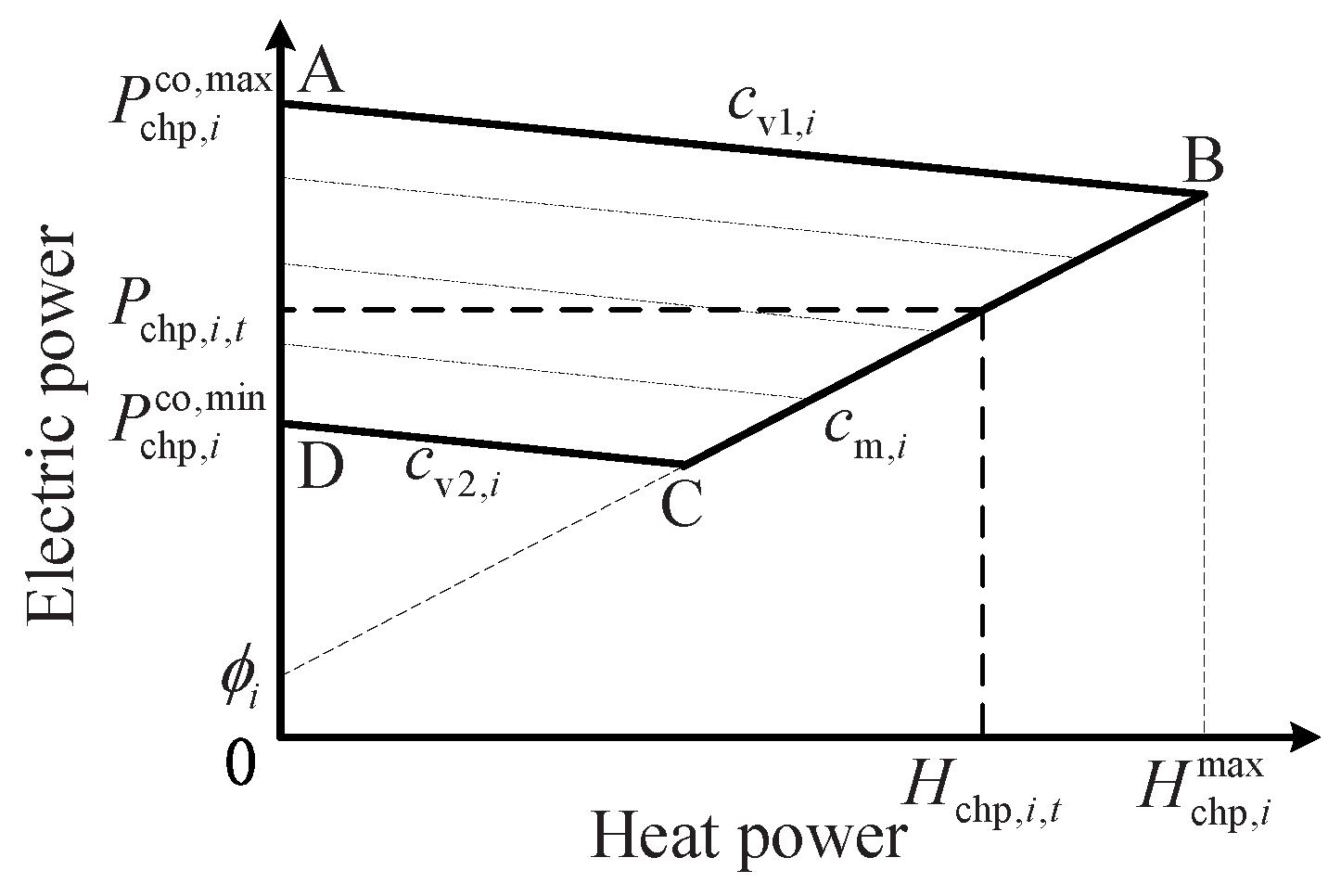
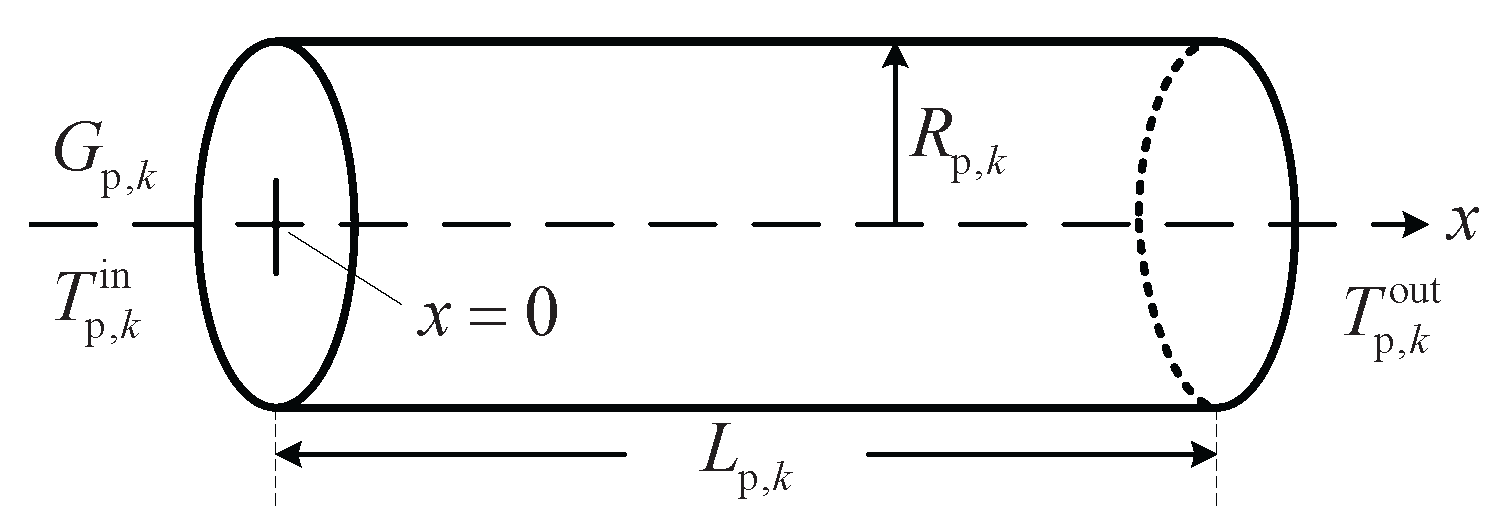

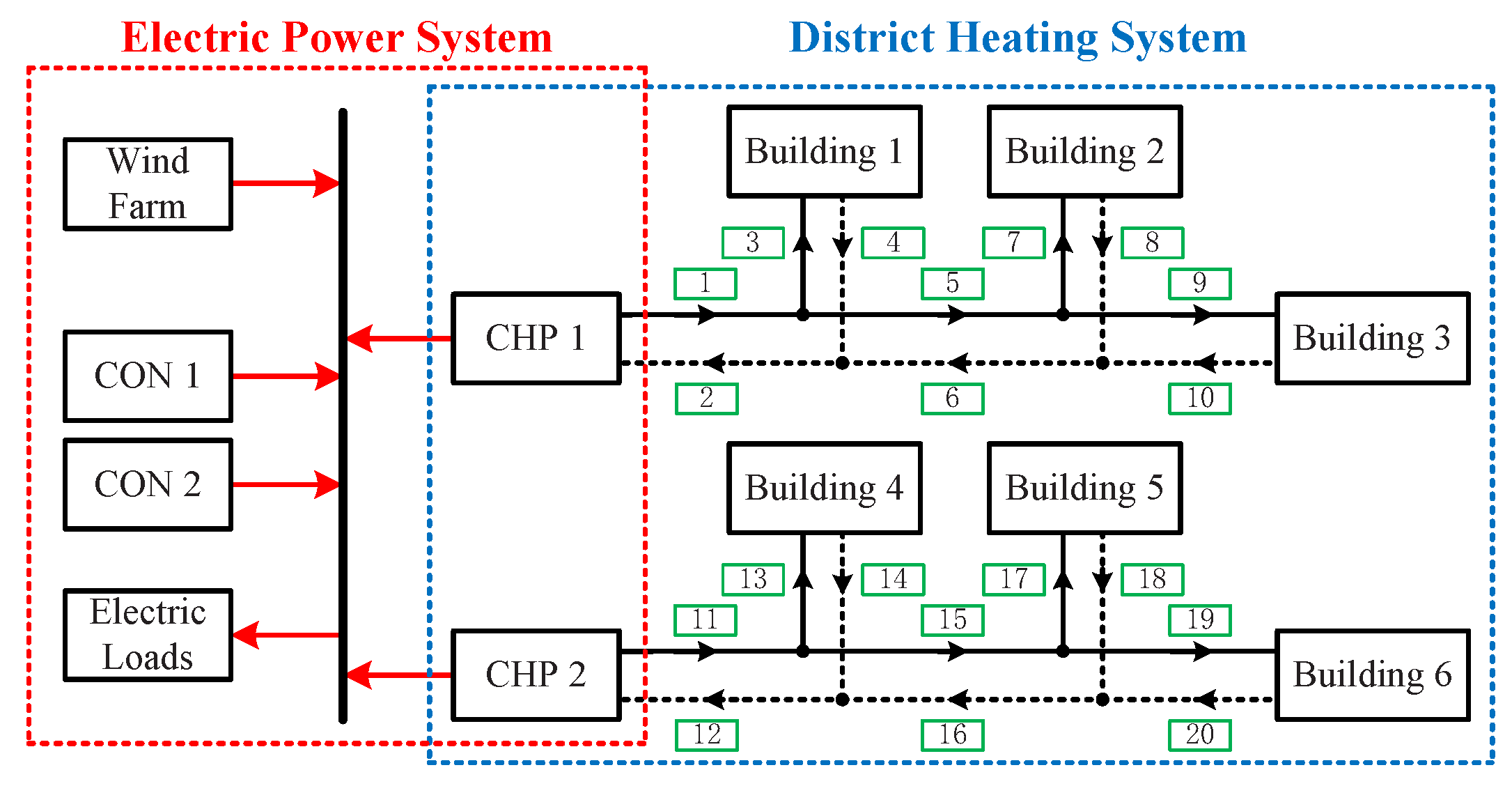
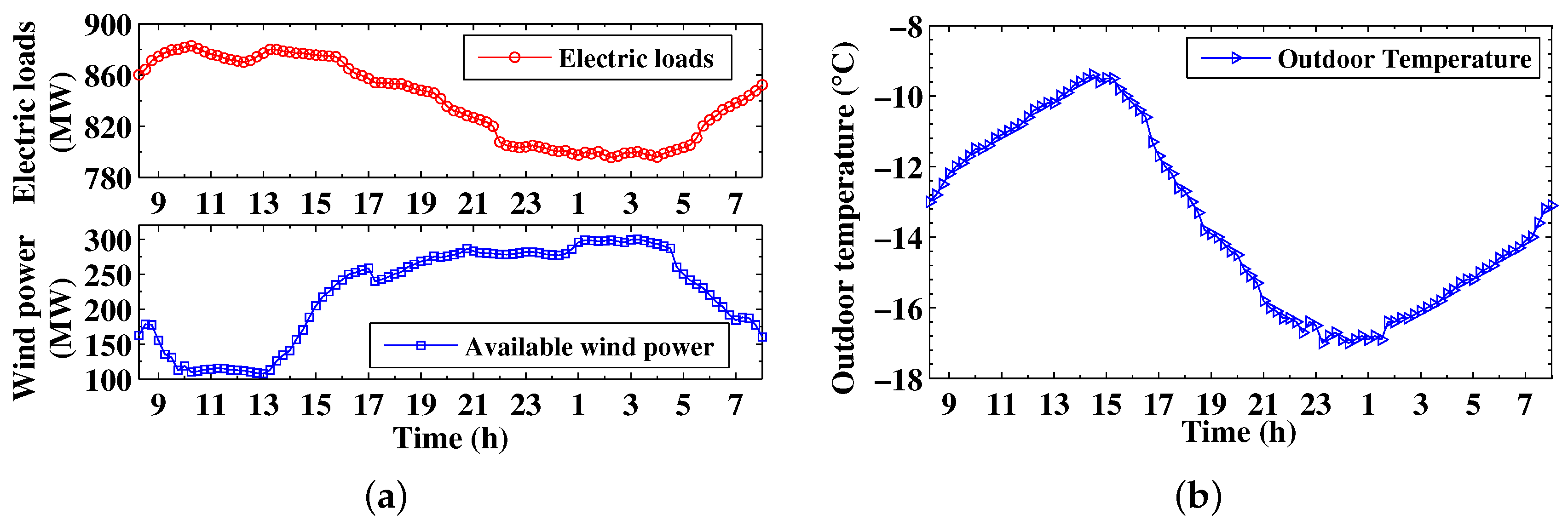
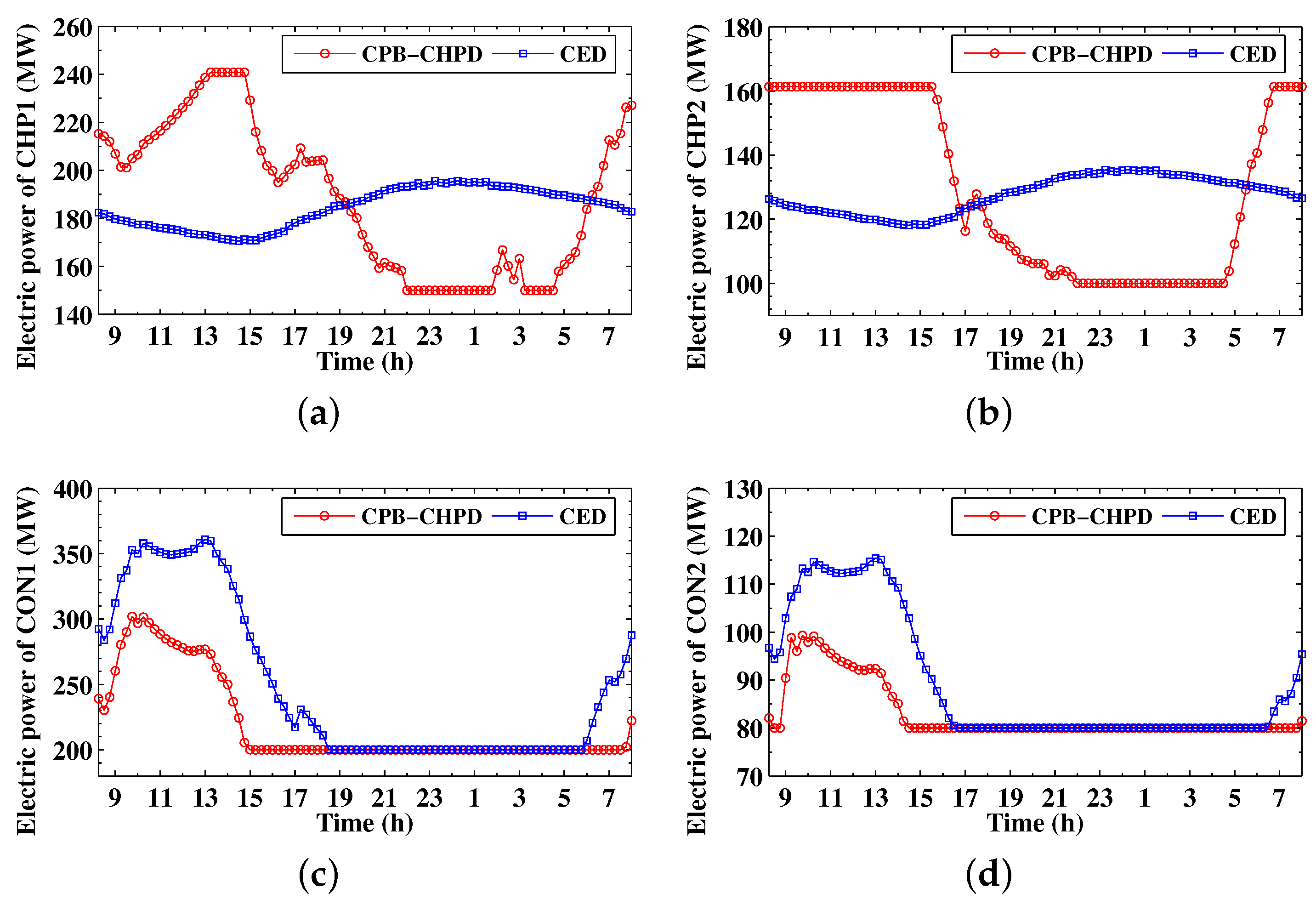
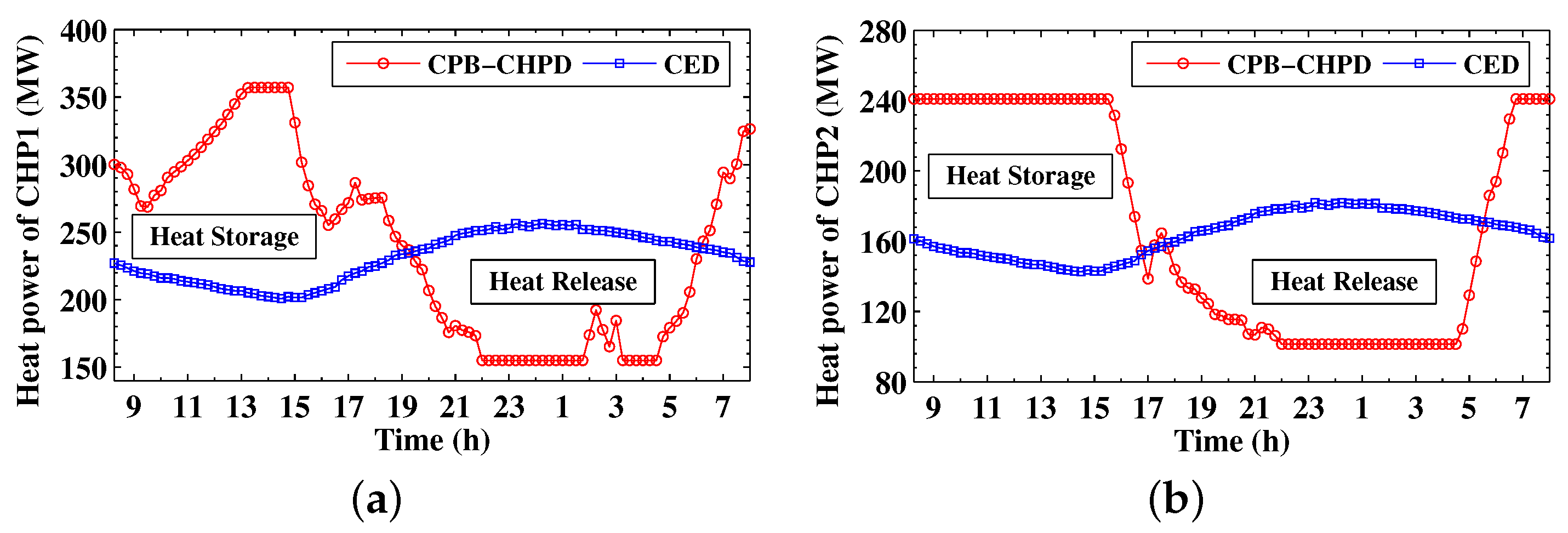
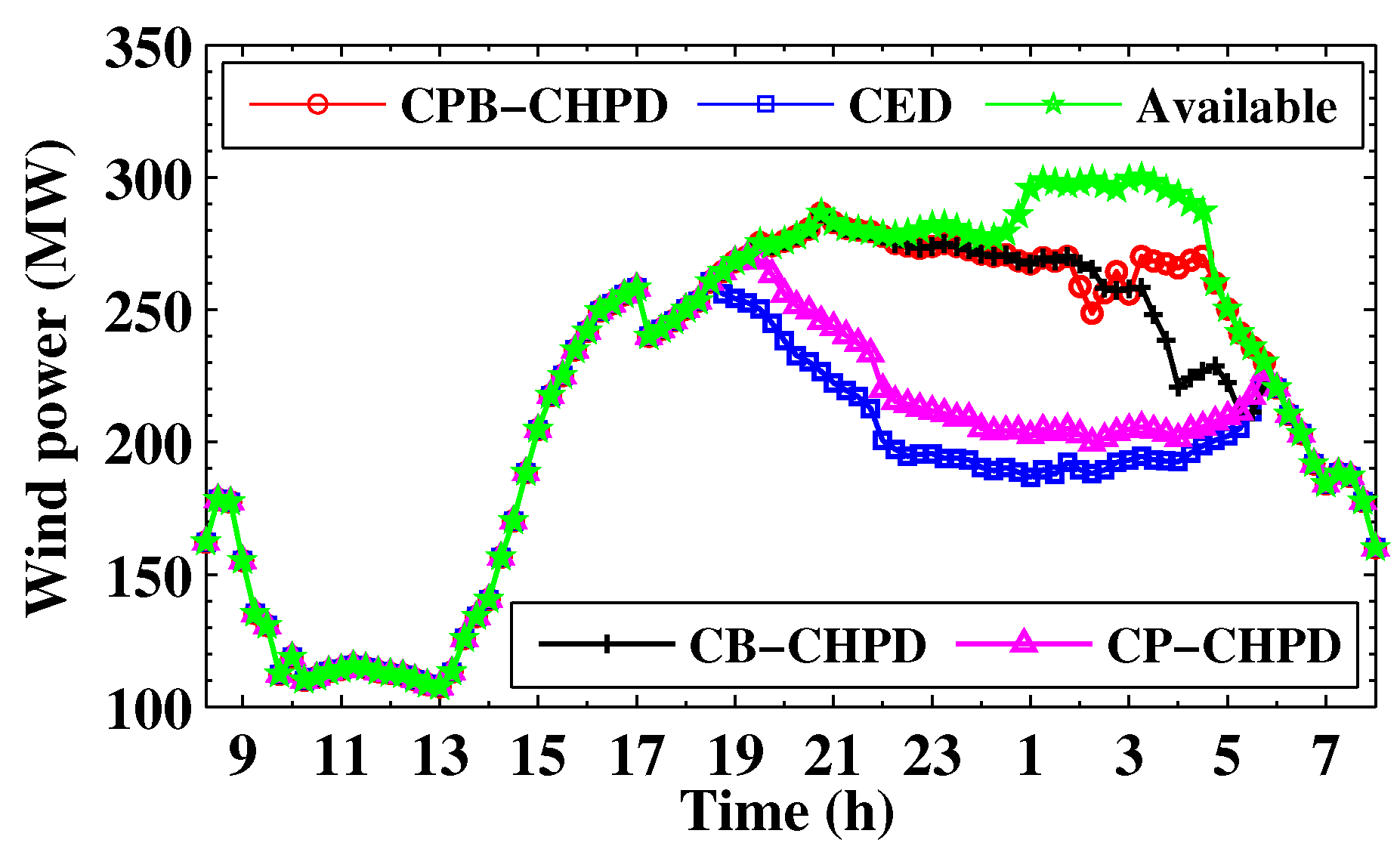
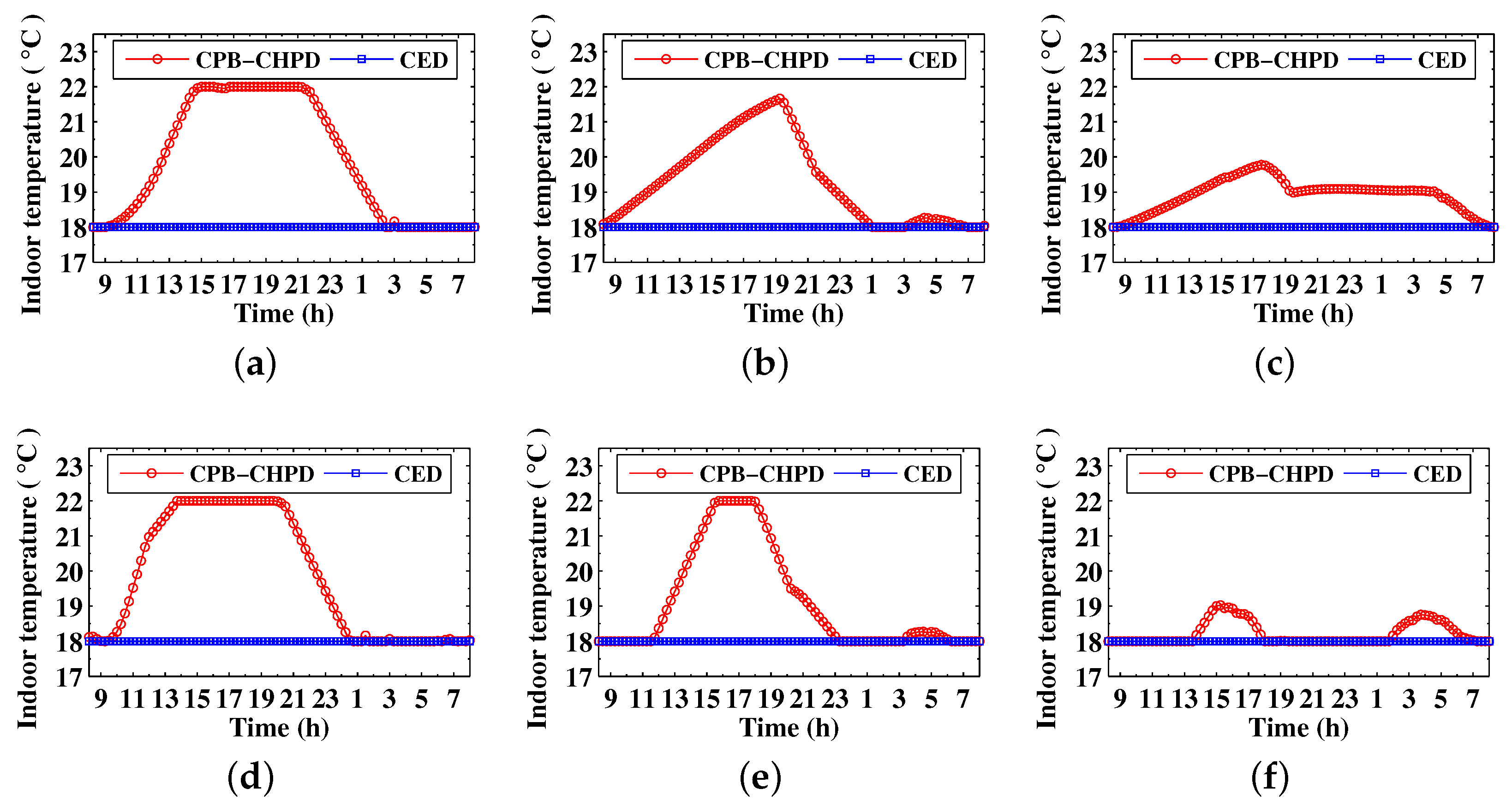

| Type | CHP Units | CON Units | ||
|---|---|---|---|---|
| Unit name | CHP1 | CHP2 | CON1 | CON2 |
| Capacity () | 300 | 200 | 500 | 200 |
| () | 323 | 212 | / | / |
| () | 150 | 100 | 200 | 80 |
| () | 357 | 241 | / | / |
| 0.23 | 0.21 | / | / | |
| 0 | 0 | / | / | |
| 0.45 | 0.44 | / | / | |
| Ramping rate () | 80 | 50 | 100 | 50 |
| No. | () | () | () |
|---|---|---|---|
| 1, 2, 11, 12 | 3250 | 0.8 | 32 |
| 3, 4, 5, 6, 13, 14, 15, 16 | 1500 | 0.6 | 32 |
| 7, 8, 9, 10, 17, 18, 19, 20 | 1050 | 0.5 | 32 |
| No. | () | () | Equivalent area () |
|---|---|---|---|
| 1 | 1.85 | 16.20 | 1.32 |
| 2 | 2.45 | 12.60 | 1.74 |
| 3 | 2.95 | 10.08 | 2.09 |
| 4 | 1.45 | 13.68 | 1.16 |
| 5 | 1.75 | 10.44 | 1.40 |
| 6 | 1.95 | 8.64 | 1.56 |
| Wind Power Integration () | Total Operation Costs ($) | Cost Savings Based on CED ($) | Saving Proportion Based on CED | |
|---|---|---|---|---|
| CPB-CHPD | 5239.68 | 521,741 | 70,172.55 | 11.86% |
| CB-CHPD | 5166.19 | 530,458 | 61,455.19 | 10.38% |
| CP-CHPD | 4709.51 | 575,062 | 16,866.53 | 2.85% |
| CED | 4549.97 | 591,929 | / | / |
© 2017 by the authors. Licensee MDPI, Basel, Switzerland. This article is an open access article distributed under the terms and conditions of the Creative Commons Attribution (CC BY) license (http://creativecommons.org/licenses/by/4.0/).
Share and Cite
Li, P.; Wang, H.; Lv, Q.; Li, W. Combined Heat and Power Dispatch Considering Heat Storage of Both Buildings and Pipelines in District Heating System for Wind Power Integration. Energies 2017, 10, 893. https://doi.org/10.3390/en10070893
Li P, Wang H, Lv Q, Li W. Combined Heat and Power Dispatch Considering Heat Storage of Both Buildings and Pipelines in District Heating System for Wind Power Integration. Energies. 2017; 10(7):893. https://doi.org/10.3390/en10070893
Chicago/Turabian StyleLi, Ping, Haixia Wang, Quan Lv, and Weidong Li. 2017. "Combined Heat and Power Dispatch Considering Heat Storage of Both Buildings and Pipelines in District Heating System for Wind Power Integration" Energies 10, no. 7: 893. https://doi.org/10.3390/en10070893
APA StyleLi, P., Wang, H., Lv, Q., & Li, W. (2017). Combined Heat and Power Dispatch Considering Heat Storage of Both Buildings and Pipelines in District Heating System for Wind Power Integration. Energies, 10(7), 893. https://doi.org/10.3390/en10070893





